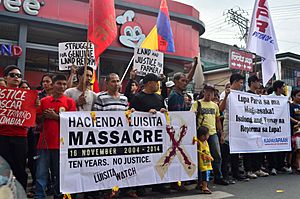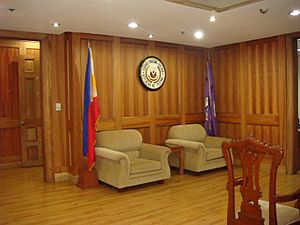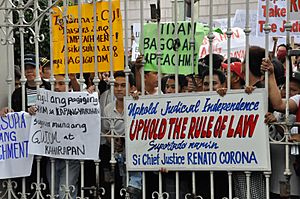Renato Corona facts for kids
Quick facts for kids
Renato Corona
|
|
|---|---|
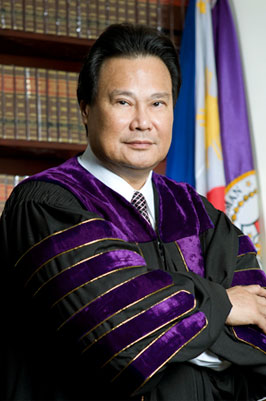 |
|
| 23rd Chief Justice of the Philippines | |
| In office May 17, 2010 – May 29, 2012 |
|
| Appointed by | Gloria Macapagal Arroyo |
| Preceded by | Reynato Puno |
| Succeeded by | Maria Lourdes Sereno (De facto) Teresita Leonardo-De Castro (De jure) |
| 150th Associate Justice of the Supreme Court of the Philippines | |
| In office April 9, 2002 – May 17, 2010 |
|
| Appointed by | Gloria Macapagal Arroyo |
| Preceded by | Arturo Buena |
| Succeeded by | Maria Lourdes Sereno |
| Chief of Staff to the President | |
| In office January 20, 2001 – April 9, 2002 |
|
| President | Gloria Macapagal Arroyo |
| Preceded by | Aprodicio Laquian |
| Succeeded by | Rigoberto Tiglao |
| Personal details | |
| Born |
Renato Tereso Antonio Coronado Corona
October 15, 1948 Santa Ana, Manila, Philippines |
| Died | April 29, 2016 (aged 67) Pasig, Philippines |
| Cause of death | Heart attack |
| Resting place | Heritage Memorial Park, Taguig, Metro Manila, Philippines |
| Spouse | Cristina Roco |
| Children | 3 |
| Education | Ateneo de Manila University (BA, LL.B,MBA) Harvard University (LL.M) University of Santo Tomas (DCL) |
| Affiliation | Fraternal Order of Utopia |
Renato Tereso Antonio Coronado Corona (born October 15, 1948 – died April 29, 2016) was an important Filipino judge. He served as the 23rd chief justice of the Philippines from 2010 to 2012. The Chief Justice is the highest judge in the country.
Before becoming Chief Justice, he was an associate justice. President Gloria Macapagal Arroyo appointed him to this role in 2002. He became Chief Justice in 2010 when Chief Justice Reynato Puno retired.
Mr. Corona was also a law professor and worked as a lawyer. He was part of the Cabinet (a group of top advisors) for former presidents Fidel V. Ramos and Gloria Macapagal Arroyo.
Contents
A Big Land Case: Hacienda Luisita
In 2011, the Supreme Court, led by Chief Justice Corona, made a very important decision. This decision was about the Hacienda Luisita case. Hacienda Luisita was a huge farm controlled by the family of the President at the time, Benigno Cojuangco Aquino III.
For many years, farmers had been fighting to get parts of this land. The original agreement for the land in 1957 said it should eventually be given to the farmers. However, the Cojuangco-Aquino family did not give the land as promised.
The Supreme Court decided that the land should be given to the farm workers. They also said that the land should be valued from 1989, not 2011. This decision meant the Cojuangco-Aquino family had to pay a lot more money. It also meant they finally lost control of the land.
Challenges for Farmers
The fight over Hacienda Luisita lasted almost 50 years. The Cojuangco-Aquino family used their power to make the legal battle very long. This made it hard for the poor farmers.
In 1987, many farmers marched to the Malacañang Palace to ask for the land. Sadly, 13 protesting farmers were shot in an event known as the "Mendiola Massacre." In 2004, more farmers protested against losing their jobs. Farmers and their supporters were shot again in what was called the "Hacienda Luisita Massacre."
The Impeachment of Chief Justice Corona
A few months after the Hacienda Luisita decision, Chief Justice Corona faced a serious challenge. On December 12, 2011, the House of Representatives voted to impeach him. Impeachment is a process where a high official is accused of wrongdoing and can be removed from office.
Many people believed this impeachment was connected to the Hacienda Luisita decision. Critics said it was a way to get back at the Chief Justice for his ruling. They also said it was meant to scare others who might go against the government.
The Trial and Verdict
The impeachment complaint was sent to the Senate for a trial. Chief Justice Corona was accused of not fully reporting his wealth. He argued that some of his foreign bank accounts were private under Philippine law. He also said the case against him was politically motivated.
On May 29, 2012, the Senate found him guilty. Twenty out of twenty-three senators voted to remove him from office. This was the first time a high-level Philippine official had been impeached and removed. Chief Justice Corona stated that "ugly politics prevailed" and his "conscience is clear."
Later, some senators who voted to convict Corona said that government funds were used to influence their votes. This money came from a program called the "Disbursement Acceleration Program" (DAP). The Supreme Court later ruled that the DAP was unconstitutional.
Judicial Independence
The impeachment of Chief Justice Corona was seen by many as an attack on the judiciary. The judiciary is the branch of government that includes the courts and judges. It is supposed to be independent from the President and Congress.
During the impeachment trial, many people supported Chief Justice Corona. They held daily gatherings outside the Supreme Court. Farmers from Hacienda Luisita also came to support him. They called him the "Champion of Agrarian Reform" because of his decision in their land case. They stood with him as he fought for the independence of the courts.
Early Life and Education
Renato Tereso Antonio Coronado Corona was born on October 15, 1948, in Santa Ana, Manila, Philippines. His father, Juan M. Corona, was a lawyer. His mother was Eugenia Ongcapin Coronado. He was married to Cristina Basa Roco, and they had three children and six grandchildren.
Schooling and Law Studies
Mr. Corona was a very good student. He graduated with honors from Ateneo de Manila grade school in 1962 and high school in 1966.
He earned his Bachelor of Arts degree from Ateneo de Manila in 1970. He was also the editor-in-chief of the university newspaper, The GUIDON. He then studied law at the Ateneo Law School, finishing in 1974. He did very well on the bar examination, which lawyers must pass to practice law.
He continued his education, earning a Master of Business Administration (MBA) degree. In 1981, he went to Harvard Law School in the United States. He earned his Master of Laws (LL.M.) degree there in 1982. He also earned a Doctor of Civil Law degree from the University of Santo Tomas, graduating with the highest honors.
Becoming Chief Justice
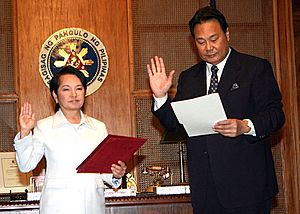
On May 12, 2010, Renato Corona was appointed the 23rd Chief Justice of the Supreme Court of the Philippines. This happened shortly before President Gloria Macapagal Arroyo's term ended. He took over from Chief Justice Reynato Puno.
His appointment caused some debate. Some people, including then-presidential candidate Benigno Aquino III, questioned it. This was because the Constitution has rules about presidents making appointments close to elections. However, the Supreme Court had already ruled that the President could appoint a Chief Justice during this time.
After Impeachment
After his impeachment, Chief Justice Corona faced other legal challenges. However, in June 2016, the criminal cases against him were dismissed because he had passed away.
Death
Renato Corona died on April 29, 2016, at the age of 67. He passed away in Pasig due to complications from a heart attack. He also had kidney disease and diabetes.
Images for kids


